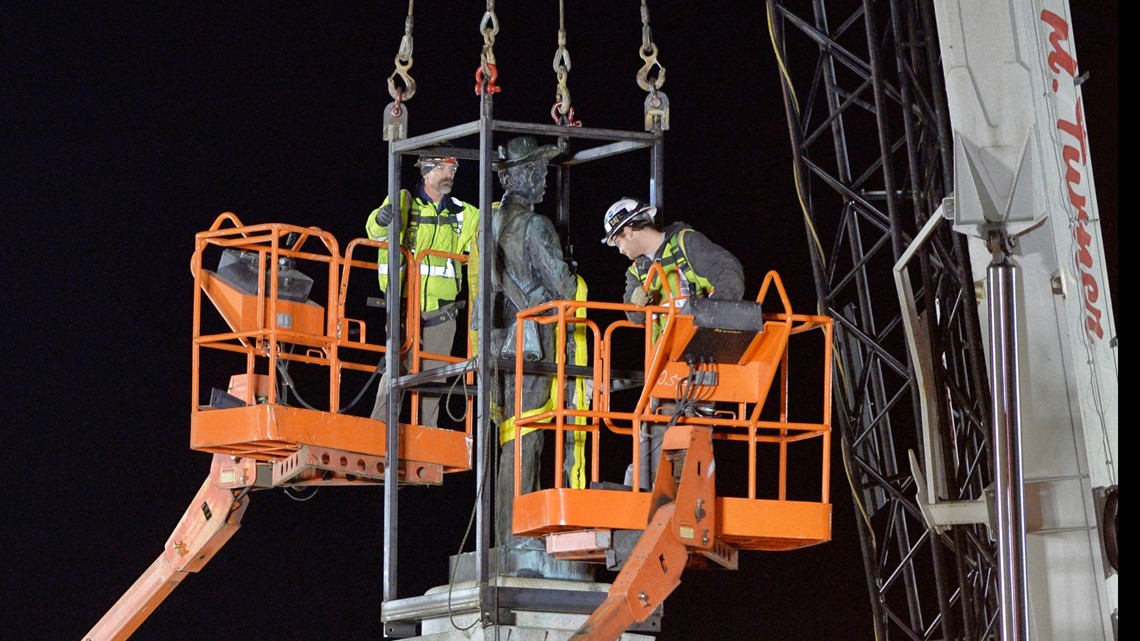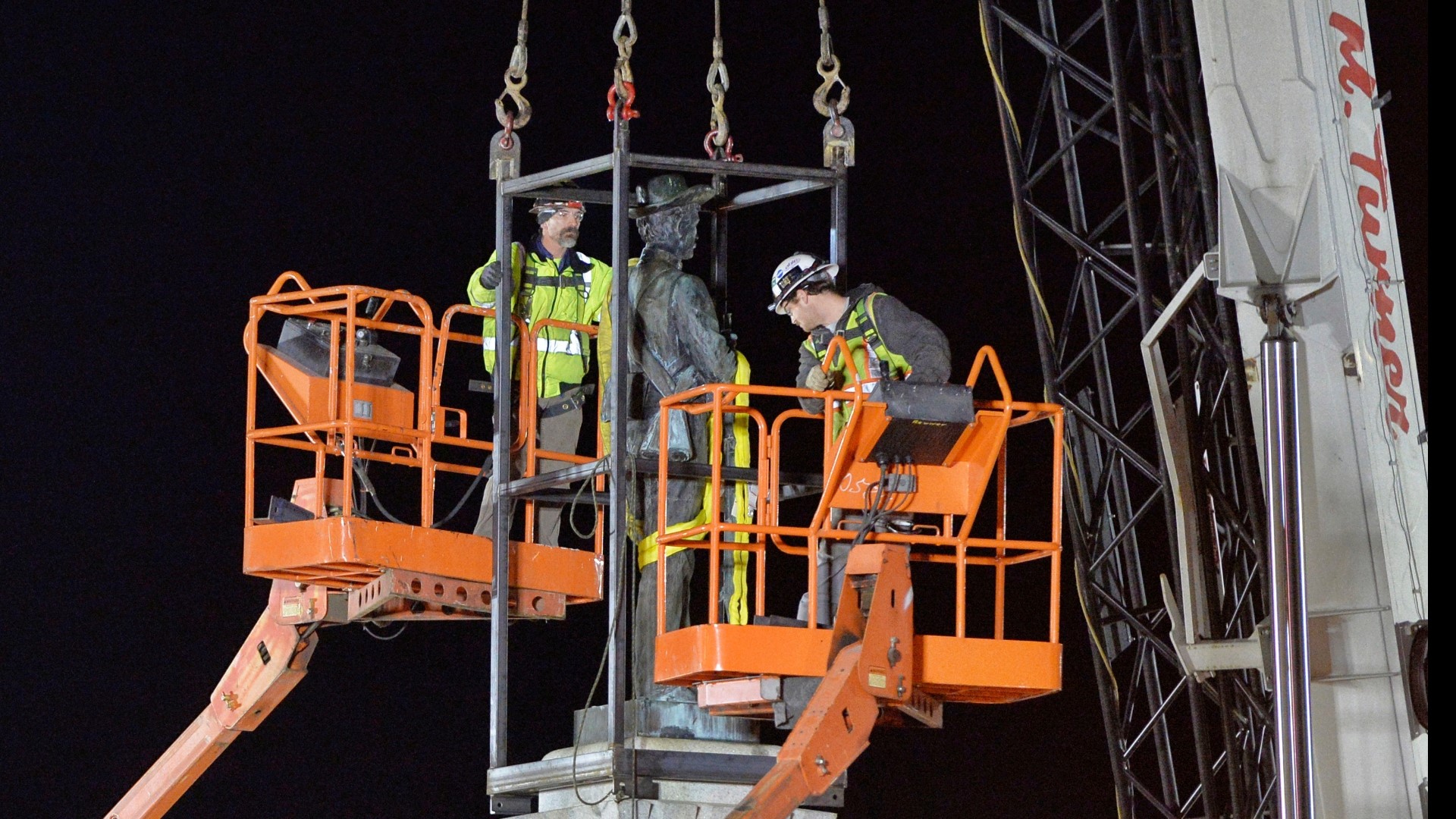PITTSBORO, N.C. — A North Carolina county removed a Confederate statue from a historic courthouse early Wednesday, joining the handful of places around the state where such monuments have come down in recent years despite a law protecting them.
Preparations began Tuesday night to carefully dismantle the statue of a soldier outside the historic Chatham County courthouse, where it had stood since 1907, and continued for hours overnight, said county spokeswoman Kara Lusk Dudley. By dawn, even the base was gone.
A subdued crowd of several dozen people watched the work unfold. Television news footage showed workers atop motorized lifts secure the statue, which was then hoisted away by a crane as a few people cheered.
The removal comes months after Winston-Salem officials removed a Confederate statue from land there that had passed into private hands. Protesters have also torn down two such monuments in recent years, including one at a historic Durham courthouse and another on the campus of the University of North Carolina at Chapel Hill.
It has been rare for public officials to take down Confederate statues in North Carolina since the enactment of a 2015 state historic monuments law restricting the removal of public monuments.


But county officials argued in court that the monument was private property, owned by the United Daughters of the Confederacy, and a judge hearing the group’s challenge declined to block the removal.
Crews closed two highways that intersect at a traffic circle around the courthouse while they dismantled the statue, which stood about 27-feet (8-meters) high outside the courthouse’s front doors.
A University of North Carolina catalog of monuments says the statue depicts an anonymous soldier holding a rifle with its butt resting on the ground. It was made of stamped copper, finished to resemble bronze, atop a pedestal of granite.
A county news release said the statue and pedestal were carefully dismantled and taken to a safe location until the United Daughters of the Confederacy comes up with a plan for what to do with them.
In past weeks, demonstrators for and against removal had gathered around the statue, leading to scuffles and some arrests.
“The last several months have been a painful time for Chatham County. We’ve experienced high emotions, division and even violence which have impacted residents, businesses and the overall feel of our community,” Chatham County Board of Commissioners Chair Mike Dasher said in a statement. “What's clear now is that the overwhelming majority of our residents are eager to move forward.”
North Carolina has been at the center of the debate over what to do with Confederate monuments as one of three southern states with the most statues, according to the Southern Poverty Law Center.
More than 90 Confederate monuments stand in public places other than cemeteries around the state. A state tally shows Confederate monuments are located at contemporary or historic courthouses in about half of the state's counties.
Onlookers to the Pittsboro removal Wednesday had mixed opinions.
“It’s heartbreaking,” Robert Butler, a supporter of the monument, told WRAL-TV. “A statue’s never hurt a soul, just like a grave memorial. Do they hurt anybody?”
But Sandra Day of Moncure, who is black, told The News & Observer that she supported its removal. She said she got out of bed and put on a heavy coat to come to Pittsboro to watch the statue come down.
“It’s an honor and a privilege to be standing here,” she said. “I wanted to see it for myself.”
The controversial move in Pittsboro is far from the action taken in Salisbury. Leaders there have not had further discussion on the future of a Confederate monument there, called Fame.


"I mean, it's right in the middle of our city," outgoing Salisbury Mayor Al Heggins said as she referenced Fame, which sits in the middle of West Innes Street in downtown.
For years, Fame has divided the city. Earlier in 2019, city leaders held a forum, asking for the public to come and give their viewpoints on what they would like to see happen.
It was standing room only at the civic center as residents on both sides spoke their minds. City leaders didn't respond to comments that night, and they haven't taken definitive action on the future of the controversial monument since the public meeting.
"It is very complicated and it is very convoluted," Heggins said.
The Salisbury monument and the land it sits on is owned by the United Daughters of the Confederacy, similar to the statue in Pittsboro. Salisbury granted them the spot in perpetuity in the early 1900s.
Mayor Pro Tem David Post said there are no records of the land agreement from 1908. Post said that's when Salisbury's then Board of Aldermen approved the resolution.
He said some 19 years later, in 1927, the mayor at the time, A.H. Boyden signed an official document into record, acknowledging the agreement that was made decades earlier.
Now, Post is wondering if that was legal.
"The question is, was the grant valid? And so, if the grant is invalid, is there a statute of limitations on when you record a deed," Post asked.
Post said he believed officials in Pittsboro and other communities that decided to take down confederate monuments did the right thing, but he's not sure how close Salisbury is from doing the same thing.
"As a Jew, I would not be happy to see statues of Hitler all around Germany," said Post.
Heggins said, for years, every council has had to navigate the controversy and that under her leadership, they are acting in accordance with state law.
When asked if Salisbury would be ready for the monument to be taken down, Heggins responded, "That's a good question. Because we have such a divide, it is such a polarized issue -- our community would have to move very carefully and very mindfully with removal of the monument if it came to that."
A new council and mayor will be sworn in in Salisbury in December, and the community will wait and see if they will vote on the future of Fame.
In Pittsboro, time will tell how the community responds to the statue's removal.

